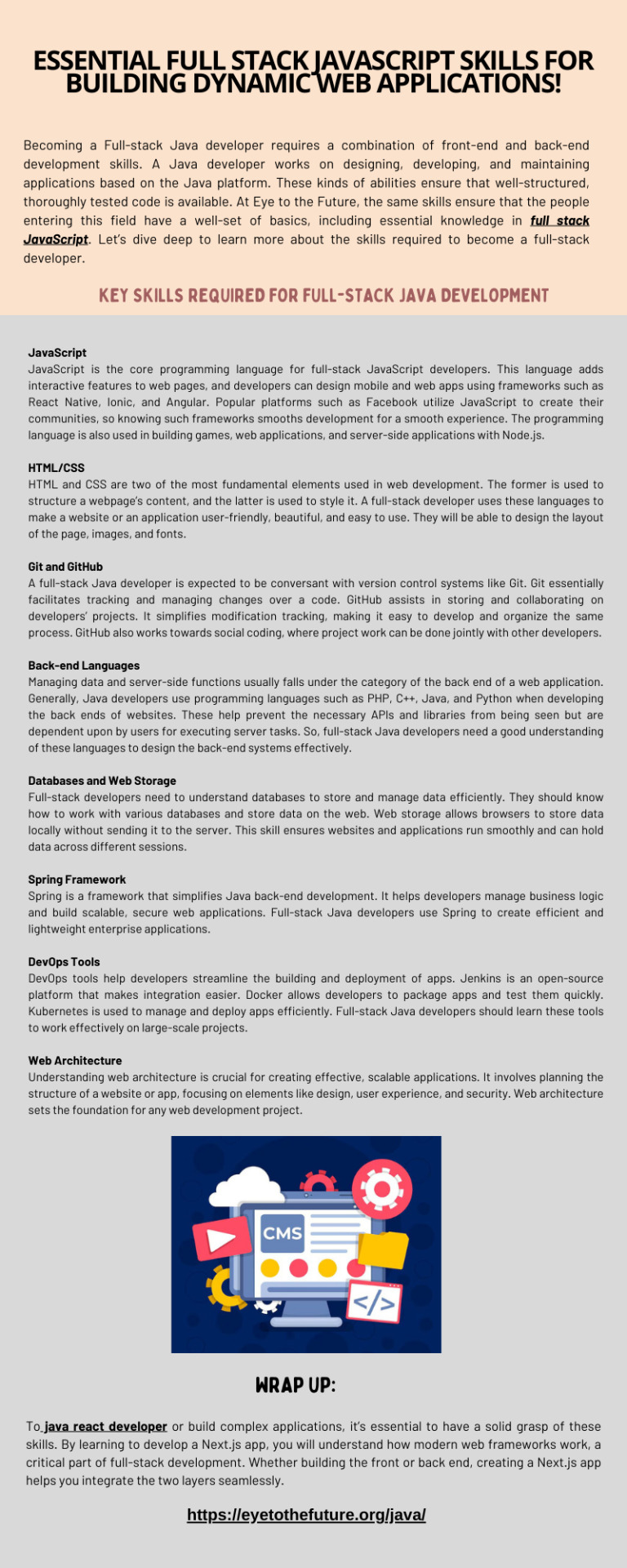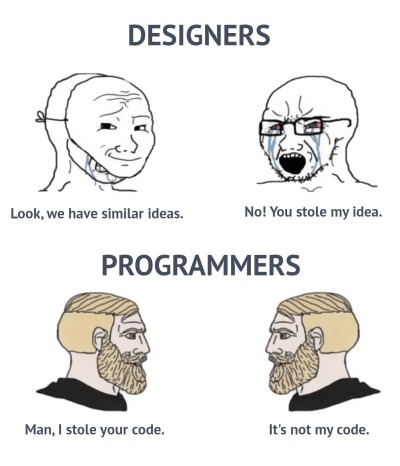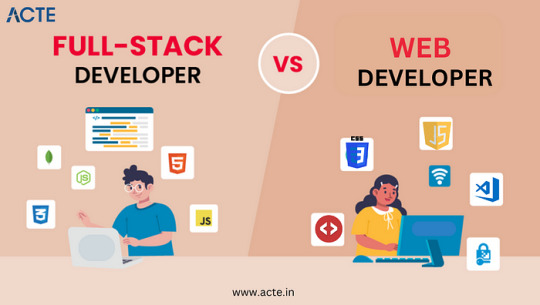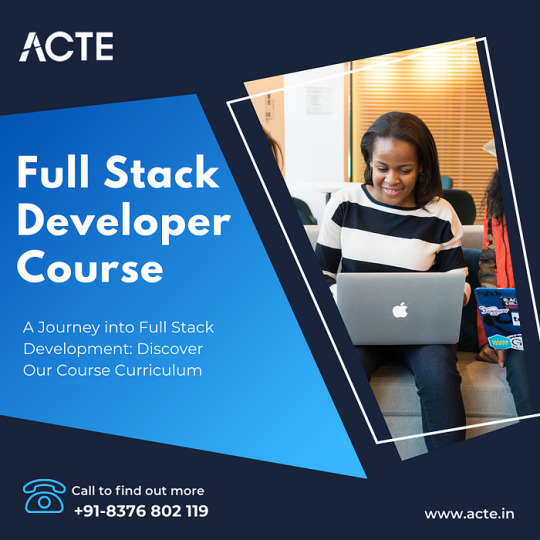#Full Stack JavaScript
Explore tagged Tumblr posts
Text

Become a Full Stack Developer with the MERN Stack Course by MindCoders – Indore’s Leading Tech Institute
Kickstart your career in web development with MindCoders’ advanced MERN Stack Development Course in Indore. This hands-on program covers MongoDB, Express.js, React.js, and Node.js, equipping you with the skills to build dynamic, full-stack web applications from scratch. Learn from industry experts, work on real-world projects, and gain job-ready experience in frontend and backend technologies. Whether you're a beginner or looking to upskill, this course is perfect for aspiring developers aiming to thrive in the tech industry.
Join MindCoders in Indore and become a certified MERN Stack Developer ready for global opportunities.
#MERN Stack Development#MERN Stack Course#Full Stack Development#Web Development Course#Learn MERN Stack#MongoDB Express React Node#Full Stack Developer Training#MERN Stack Training#Coding Bootcamp#Web App Development#JavaScript Developer Course#Full Stack JavaScript#MindCoders MERN Course#MERN Stack Projects#Software Development Course
0 notes
Text
Essential Full Stack JavaScript Skills for Building Dynamic Web Applications!

Becoming a Full-stack Java developer requires a combination of front-end and back-end development skills. A Java developer works on designing, developing, and maintaining applications based on the Java platform. These kinds of abilities ensure that well-structured, thoroughly tested code is available. At Eye to the Future, the same skills ensure that the people entering this field have a well-set of basics, including essential knowledge in full stack JavaScript. Let’s dive deep to learn more about the skills required to become a full-stack developer.
0 notes
Text

When you find out that your 'original' code is just a copy of a copy of a copy...
#programmer humor#programming#geek#nerd#programmer#computer#python#laptop#c#meme#pc#computer science#java#developer#software developers#full stack web development#code#cs#javascript#c++#software engineer#software development#dev#web development
133 notes
·
View notes
Text
Social media break end...
Hi again folks! I'm back after a lil hiatus. We all need time away from social media but now that I'm back, I will be posting up some handy tips in the upcoming weeks.
I've been accepted onto the CFG degree which starts next week. I can't wait to get stuck in and really delve into full stack programming.
I've got a personal project I'm working on that I'll share snippets of every now and then. Hopefully you'll be able to see the progress and enjoy the ride with me. (And of course, if you have any ideas on how to improve things I would be all ears!)
Happy coding lovelies!
❄️
4 notes
·
View notes
Text
Any MCR fans in software engineering/web dev?
I'm looking for mutuals who love to code and also love MCR. I wanna do a little project >:D also just want some buds to relate to.

#my chemical romance#mcr#software engineering#web development#web developers#python#c++ programming#programming#programmer#github#coding#baby coder#codeblr#react#java#javascript#reactjs#frontenddevelopment#learntocode#webdev#nodejs#full stack developer#gerard way#frank iero#my chem gerard#mikey way#ray toro
2 notes
·
View notes
Text
youtube
#online courses#coding#graphic designing#web design#ict skills#india#hindi#gujarati#english#www.ictskills.in#online training#live training#full stack course#digital marketing#ui ux design#backend#online#live courses#courses#education#computer science#engineering#java#python#php#dot net development company#spring mvc#javascript#Youtube
2 notes
·
View notes
Text

Days 128 to 129
I have worked hard on my portfolio site and added some cool animations and tool tips. I have done lots of prettying up as well. Tomorrow I'll fully implement the contact page.
#self improvement#cosmickittytalk#codeblr#csharp programming#csharp#csharp is superior#girls who code#programming#coding challenge#blazor#blazor programming#blazor website development#javascript#html css#html5 css3#htmlcoding#html5#css3#css animation examples#css#web development#website#front end development#full stack developer#coding for a year#coding#website development#website design#website animation#animated website
13 notes
·
View notes
Text
Top 10 Front-End Frameworks and Libraries for 2024
As the web development landscape continues to evolve, staying updated with the latest front-end frameworks and libraries is crucial for any developer. Whether you're a seasoned pro or just starting out, knowing which tools to use can significantly impact your productivity and the quality of your projects. In this post, we’ll explore the top 10 front-end frameworks and libraries that are set to dominate in 2024.
1. React
React remains one of the most popular front-end libraries, known for its simplicity and flexibility.
Key Features of React
Component-Based Architecture: Reusable components make development efficient and manageable.
Virtual DOM: Enhances performance by minimizing direct DOM manipulation.
Strong Community Support: A vast ecosystem of tools, libraries, and tutorials.

2. Angular
Angular, backed by Google, is a powerful framework for building dynamic single-page applications (SPAs).
Why Choose Angular?
Two-Way Data Binding: Synchronizes data between the model and the view.
Dependency Injection: Improves code maintainability and testability.
Comprehensive Documentation: Extensive resources for learning and troubleshooting.

3. Vue.js
Vue.js has gained popularity due to its gentle learning curve and versatility.
Advantages of Vue.js
Reactive Data Binding: Simplifies state management.
Single-File Components: Encapsulate HTML, CSS, and JavaScript in one file.
Flexibility: Can be used for both large-scale and small-scale applications.

4. Svelte
Svelte is a relatively new player that compiles components into highly efficient vanilla JavaScript at build time.
Svelte’s Standout Features
No Virtual DOM: Directly manipulates the DOM for better performance.
Less Boilerplate: Cleaner code with minimal overhead.
Ease of Use: Intuitive and straightforward syntax.

5. Bootstrap
Bootstrap is a front-end framework that provides pre-designed components and a responsive grid system.
Benefits of Using Bootstrap
Responsive Design: Ensures your site looks great on all devices.
Pre-Styled Components: Saves time with ready-to-use UI elements.
Customizable: Easily customize with Sass variables and Bootstrap’s extensive options.

6. Tailwind CSS
Tailwind CSS is a utility-first CSS framework that allows for rapid UI development.
Tailwind CSS Features
Utility-First Approach: Use utility classes directly in your HTML.
Customizable: Extensive configuration options to suit your project’s needs.
Consistency: Enforces a consistent design language across your project.

7. Ember.js
Ember.js is a robust framework for building ambitious web applications.
Why Ember.js Stands Out
Convention over Configuration: Reduces the amount of decision-making and boilerplate code.
Strong Routing: Powerful routing capabilities for managing application state.
Productivity: Focuses on developer productivity with built-in best practices.

8. Alpine.js
Alpine.js offers a minimal and lightweight way to add interactivity to your websites.
Key Features of Alpine.js
Lightweight: Small footprint with only a few kilobytes.
Declarative Syntax: Similar to Vue.js, making it easy to understand and implement.
Ease of Integration: Can be easily integrated into existing projects.

9. Next.js
Next.js is a popular React framework that enables server-side rendering and static site generation.
Benefits of Using Next.js
Server-Side Rendering (SSR): Improves performance and SEO by rendering pages on the server.
Static Site Generation (SSG): Pre-renders pages at build time for fast load times.
API Routes: Allows you to create API endpoints within your application.

10. Lit
Lit is a simple library for building fast, lightweight web components.
Advantages of Lit
Web Components: Embraces the web components standard for reusable, encapsulated HTML elements.
Performance: Lightweight and highly performant.
Simple API: Easy to learn and use with a minimal API surface.

Conclusion
Choosing the right front-end framework or library can significantly impact your workflow and the quality of your projects. Whether you prefer the flexibility of React, the structure of Angular, or the simplicity of Svelte, there's a tool out there to suit your needs.
Final Tips for Selecting a Framework or Library
Project Requirements: Consider the specific needs of your project.
Community and Support: Look for frameworks with strong community support and documentation.
Learning Curve: Choose a tool that matches your current skill level and the time you have available to learn.
By staying informed about the latest tools and trends, you can ensure that your skills remain relevant and that you can deliver the best possible results in your projects. Happy coding!
Remember, the best tool is the one that helps you get the job done efficiently and effectively. So, dive into these frameworks and libraries, and take your front-end development skills to the next level!
Share Your Thoughts
I'm curious to know your thoughts on these front-end frameworks and libraries. Have you used any of them in your projects? Which one is your favorite, and why? Share your experiences and insights in the comments below.👇
2 notes
·
View notes
Text


I haven't been able to work on my dress up games or cursed ads because I had to learn contentful for freelancing...tbh just learn some php (or twig) and do wordpress. The contentful docs are horrible, no examples, it is impossible to find anything specific in them, no templates if you are not paying premium...I just hate this trend of programmers reinventing things that already work just to be javascript, it ends up being so clunky and unfinished 90% of the time...let's make learning more than one programming language normal again 😭 especially for full stack projects...
#codeblr#progblr#studyblr#coding#webdevelopment#contentful#programming#full stack web development#cms#cmsdevelopment#javascript#nextjs
3 notes
·
View notes
Text
Full Stack Developer Course in Varanasi with Placement.
The Full Stack Development Course in Varanasi offers a comprehensive curriculum covering both front-end and back-end technologies. Designed to impart a well-rounded skill set, the course equips participants with proficiency in various programming languages, frameworks, and tools essential for full stack development. Emphasizing practical learning, the program provides hands-on experience in building and deploying applications, ensuring students are well-prepared for real-world challenges. This Full Stack Development course in Varanasi follows industry best practices, preparing participants for a successful career in the dynamic and evolving field of full stack development.

2 notes
·
View notes
Text
My Perspective on Distinguishing Between Full Stack Developers and Web Developers
I can’t help but go back to my own experience as a web developer as I sit down to write about the difference between full stack developers and web developers. This subject has a special meaning to me since it captures the essence of navigating this fast-paced industry. In order to better appreciate the contrasts between these two jobs, let’s set out on a voyage, and I’ll share my viewpoint and experiences along the way.
We frequently mix the terms “full stack developer” and “web developer” while discussing web development. They stand for several jobs, each with their own set of tasks and abilities. Whether you’re an experienced developer, a newcomer in the industry, or someone pursuing a career in technology, it’s vital to comprehend these contrasts.
Defining Full Stack Developers and Web Developers
Developers who work on the complete stack: Let’s start by defining a full stack developer. In terms of web development, a full stack developer is essentially a jack of all crafts. Both front-end and back-end technologies are familiar to them. This implies that they are capable of managing databases and server-side functionality in addition to designing the user interface. They are essentially the Swiss Army tools of web development.
Web Developers: known as front-end developers — concentrate mostly on the client side of web development. They are masters in using HTML, CSS, and JavaScript to create stunning and engaging user interfaces. Their main objective is to provide a smooth and visually pleasing user experience on a website.

I had a basic comprehension of these jobs when I first started working as a web developer. Like many novices, I mistakenly believed that web programming was solely about producing visually stunning websites. But I quickly understood there was much more to it.
Common Ground: Overlapping Skills
It’s important to acknowledge the areas of overlap between web developers and full stack developers before we get into their distinctions. A solid foundation in front-end development is necessary for both professions. HTML, CSS, and JavaScript proficiency are essential. These languages are your building blocks whether you’re creating a user interface or incorporating sophisticated capabilities.
These front-end abilities were the start of my adventure. I devoted endless hours to polishing my HTML structures, honing my CSS stylesheets, and exploring JavaScript’s potential as an interactive language. These abilities laid the foundation for my profession and are still crucial today.
Delving into Full Stack Development
Let’s now explore full stack development, where the distinctions are more apparent. In addition to being experts in front-end technologies, full stack developers are also knowledgeable in back-end technologies. This covers database management as well as server-side programming languages like Python, Ruby, or Node.js.
Making the switch to back-end development was a turning point for me. Working with databases and server logic first made me feel uneasy. I took the challenge, though, and began studying server-side languages and databases. Even if things weren’t always easy, every challenge I overcame helped me become a better developer.
Web Development: Focusing on the Front End
Web developers, on the other hand, focus on the front end. Their area of expertise is designing captivating, engaging user interfaces. They take great care in website design, making sure that it is aesthetically pleasing, responsive, and user-friendly.
I still clearly recall my first front-end-focused web programming project. Making an interactive and practical design come to life was thrilling. Web developers enjoy the particular high of witnessing a beautifully designed website in use.
Bridging the Gap: The Versatility of Full Stack Developers
The capacity to integrate front-end and back-end development is one of the defining traits of full stack engineers. This adaptability is revolutionary in the tech sector. Full stack developers are able to handle all aspects of development, taking a project from inception to conclusion.
Being a full stack developer has provided me with access to a variety of projects. I’ve had the honor of working on anything from data-driven applications to e-commerce websites. This versatility has improved my skill set and given me the ability to take on a variety of difficulties.
My Personal Journey
I can’t help but thank the mentors, classes, and resources that have molded my perspective as I consider my career as a developer. Participating in coding groups, taking full stack developer courses provided by ACTE Institute, and learning from seasoned developers have all been extremely beneficial to my development.

Realizing that no one becomes a full stack developer or web developer over night is essential. It is a path of ongoing learning and development. And keep in mind that each person’s journey is distinctive, formed by their experiences and decisions.
The Ever-Changing Tech Landscape
The only thing that is consistent in the tech sector is change. Both web developers and full stack developers need to keep up with the latest trends and technology. Adaptability is essential, from the emergence of new programming languages to the development of front-end frameworks.
I’ve seen firsthand how quickly tools and techniques for web development have advanced. In this always changing sector, adapting to change and remaining curious have been essential.
In conclusion, anyone navigating the IT sector needs to be aware of the differences between full stack engineers and web developers. Each role has its own advantages and difficulties. Remember that your path as a developer is an ongoing discovery whether you decide to focus on one or embrace the variety of the other.
#full stack developer#web development#full stack web development#frameworks#education#information#technology#front end development#back end#javascript
2 notes
·
View notes
Text
India’s Best Student Learning Platform for Tech Skills
My Growth Crafter is a dedicated student learning platform offering curated content, interactive courses, and career-oriented mentorship. Join a community focused on future-ready skills and hands-on learning.

#MERN full-stack development workshop#learn full-stack web development#MongoDB Express React Node training#front-end and back-end coding#JavaScript development course
0 notes
Text
What Is The Purpose of JUnit In Java Application Testing?
JUnit is a widely-used testing framework in Java that plays a critical role in unit testing ensuring that individual components (typically methods) of a program work as intended. Its purpose is to automate the process of testing Java applications by enabling developers to write repeatable tests and run them efficiently.
JUnit provides annotations like @Test, @BeforeEach, @AfterEach, and assertions such as assertEquals(), assertTrue(), and assertNotNull() that make it easy to write readable and maintainable test cases. By isolating and testing individual methods or classes, JUnit helps developers detect bugs early in the development cycle, preventing costly issues later in production. It also supports test-driven development (TDD), where tests are written before the actual code, promoting better software design and reduced debugging time.
Integrated with build tools like Maven or Gradle and CI/CD platforms like Jenkins, JUnit becomes a core part of the software delivery pipeline. It enables continuous testing, automated builds, and faster deployment with higher code quality.
Overall, JUnit enhances the reliability, maintainability, and robustness of Java applications, making it an essential skill for anyone learning or working in Java development.
To master such testing tools and become job-ready, consider enrolling in a comprehensive java full stack developer course.
0 notes
Text
Does learning Java increase my salary?
1. Introduction to the Java Job Market
Java is still one of the hottest programming languages out there. Whether you're just starting or have been coding for a while, knowing Java can really help your career. A common question is: Does learning Java boost my paycheck? The answer is yes—companies really want people who know Java because it's so flexible for web, mobile, and big business apps. Key topics include Java programming, Java developers, and job roles related to it.
Key Point: Java skills are in demand across different industries and can help increase your salary.
2. Java's Popularity and Market Demand
Big names like Amazon, Netflix, and Google use Java because it handles large-scale apps well. So, does learning Java increase my salary? Definitely. Employers will pay a premium for those who are good at Java. Key terms include Java software development, full stack, and backend developer.
Key Point: There’s a strong demand for Java devs, which leads to better pay and job security.
3. Java Skills and Salary Growth
Having Java skills gives you an edge. Companies are looking for people who know frameworks like Spring Boot and tools like Maven. Will learning Java increase my salary? For sure. With the right certifications and experience, you can earn more. And signing up for a Java course in Coimbatore can really help solidify your skills.
Key Point: Specialized Java knowledge can lead to promotions and salary increases.
4. Role of Certifications in Salary Hike
Getting a Java certification is a smart way to stand out. A lot of people choose the Java Full Stack Developer Course in Coimbatore for hands-on practice. Certifications prove your skills, and the answer to the question: Does learning Java bump up my salary? Yes.
Key Point: Java certifications help validate your skills and can lead to better pay.
5. Java Job Roles and Their Pay Scales
Java jobs range from junior developers to senior architects, and each level comes with higher pay. A Java training in Coimbatore can get you ready for roles like Full Stack Developer or Software Engineer. Is there a salary increase if you learn Java? Absolutely, especially for specialized roles.
Key Point: There are many roles in Java, and each offers attractive salary packages.
6. Java vs. Other Programming Languages in Salary
Java developers often earn more than those working with less popular languages. Unlike some newer languages, Java jobs tend to be more stable. Does learning Java mean better pay? Yes, compared to other languages, Java usually offers more consistent salaries.
Key Point: Java's long-standing presence in the industry generally means better pay than many newer languages.
7. Full Stack Java Developer Salary Benefits
Full Stack Java Developers are among the best paid in tech. Taking a Java Full Stack Developer Course in Coimbatore can prepare you for the job market. Will learning Java increase my salary? For sure—especially in full stack roles where you need to be skilled in both backend and frontend.
Key Point: Full Stack Java positions offer top salaries and are in high demand.
8. Java's Role in Enterprise Applications
Java is key for many enterprise systems. Learning enterprise-level Java can really answer the question: Does it help me earn more? Yes. A training program in Coimbatore that teaches things like Hibernate and JSP is worth considering.
Key Point: Skills in enterprise Java can set you up for well-paying jobs.
9. Local Training Institutes and Career Impact
Joining a local Java course in Coimbatore can boost your earnings. These programs offer hands-on projects and guidance from experts. So, does learning Java help with salary? Yes—local training can lead to quicker job growth.
Key Point: Local Java training can speed up your skills and help with job placements.
10. Final Thoughts and Brand Mention
In summary, does learning Java increase my salary? Yes, through certifications, full stack skills, and local training. Consider a reputable place like Xplore It Corp for training in Coimbatore, offering courses designed to meet job market needs.
Key Point: Xplore It Corp provides practical Java courses that can help you earn more.
FAQs:
1. Does learning Java help me earn more with no experience?
Yes. Even beginners can get better job offers after certified Java training.
2. What’s the average salary after a Java course in Coimbatore?
Freshers typically earn around ₹3-5 LPA, and pay can increase significantly after 1-2 years.
3. Is a Java Full Stack Developer Course in Coimbatore worth it?
Definitely. Full stack developers are in demand and usually earn 20-30% more.
4. How long before I see salary benefits after Java training?
Usually, you can expect to see salary increases within 6-12 months after completing the course.
5. Can I switch to Java and expect a pay increase?
Yes. Many people move from non-tech jobs to Java and see a boost in their salary.
#Java programming#Java developer#Java applications#Core Java#Java certification#Java frameworks#Spring Framework#Java full stack#Java backend developer#Java software development#Java training course#Java job roles#Object-oriented programming#Java IDE#Java runtime environment#Java REST API#J2EE#Java vs Python#Java vs JavaScript#Secure Java coding#Java deployment#Java enterprise solutions#Java bootcamp#Java multithreading#Java performance optimization
0 notes
Text
#code#frontenddevelopment#nextjs#reactjs#software#coding#software engineering#support me#youtube#typescript#javascript#full stack developer#frontenddesign#frontend developer#css3#html css#learn to code#css animation examples#frontendbackend#frontendframeworks
1 note
·
View note
Text
Best Java Training in Chandigarh | IT Trainings Institute

Join the best Java Training in Chandigarh at IT Trainings Institute. Gain hands-on experience with expert-led classes, real-time projects, and job placement support. Perfect for beginners and professionals looking to upskill. Start your journey in Java development today with industry-recognized certification.
#Java Training in Chandigarh#java course#it training#javascript#javaprogramming#java#python#full stack developer
1 note
·
View note